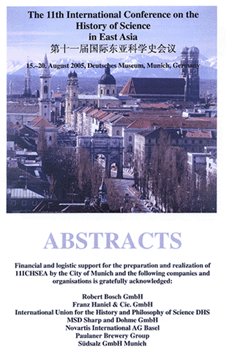Wolfgang Michel: Western Distillation Techniques and Euro-Japanese Botanical Interactions in 17th Century Japan |
THE 11TH INTERNATIONAL CONFERENCE ON THE HISTORY OF SCIENCE IN EAST ASIA (Munic, 16 Aug 2005)
Summary
Research into Western medicine in Japan usually focuses on the so-called Dutch studies (rangaku). These are said to have developed gradually due to the policy of Shogun Yoshimune of opening up Japan to practical Western science in the early 18th century. However, sources from the Dutch East India Company (VOC) together with Japanese manuscript sources confirm the existence of a similar approach to Western medicine, pharmacy, and botany from the 1650s until the early 1680s.
The barber-surgeon C. Schamberger made a strong impression on leading personalities of the Tokugawa regime during his stay in Edo in 1650-1651, which led to the rise of "Redhead-style surgery" (ŠO‰È geka) as a new medical paradigm soon after he had left Japan. Simple surgical treatments, ointments, and plasters spread throughout the country, and high-ranking officials and feudal lords started to send their physicians to be instructed by the surgeon of the Dutch trading-post in Nagasaki. The social acceptance of these new methods is demonstrated by the "diploma" provided by western surgeons to selected Japanese "students" between 1658 and 1685.
Dutch trade papers after 1652 include Japanese orders for drugs, herbs, and pharmaceutical oils, as well as for medical books and various instruments. However, as the VOC was still struggling to organize its own medical supply system in East Asia, deliveries to Japan were irregular and highly prized. Therefore, in 1668, the Tokugawa government conveyed an official request to the governor of Batavia for a Western distillation unit and a series of live plants (including spice plants) and seeds, and for the dispatch of a specialist with sound knowledge of these herbs and distillation techniques. Obviously, the aim was technology transfer and the establishment of a fully-fledged production cycle of pharmaceutical plants and oils. Understandably, no spice plants were ever delivered to Japan but, during the following years, various live plants and seeds arrived in Nagasaki to be cultivated in "the Emperor's garden". In 1669, the young apothecary G. Haeck, and two years later the more experienced F. Braun, came to Japan from Batavia. Both were asked by the Japanese governor (Nagasaki bugyo) to look for usable local plants in the vicinity of Nagasaki. On various occasions, they were also required to provide instruction on the plants sent to Japan by the company. Their reports are preserved in several Japanese manuscripts and can even be traced in books such as the "Compass of Dutch Surgery" (Oranda geka shinan, 1696).
After the arrival of a distillation unit from Europe in 1671, a hut was built at the expense of the Japanese government, and in April 1672, Braun demonstrated the production of pharmaceutical oils in the presence of government officials. The illustrated report drawn up by six Japanese interpreters shows the equipment in detail and gives a careful description of the process. Only a month later, Japanese physicians were able to produce clove oil and turpentine oil without help. Soon copies of the interpreters' report were circulated in Edo and Nagasaki.
The still at Dejima was used during the 1670s, but after Shogun Tsunayoshi came to power in 1680, it was no longer referred to in Dutch sources.
The fading interest of government officials may have been related to a change in attitude brought about by Tsunayoshi, but problems with cultivating the imported seeds and plants also played a role. Almost none survived and because spice plants and seeds were never brought to Nagasaki, the dependence on Dutch deliveries of certain oils continued.
It was always the Japanese who took the initiative in this affair, but the Dutch East India Company also pursued its own interests. A. Cleyer, a German physician who ran the VOC pharmacy in Batavia, was responsible for the company's supply of drugs and medicaments from 1667. He turned to East Asian Materia Medica to find suitable substitutes for the expensive and often damaged goods delivered from the Netherlands. Because he was responsible for the Japanese orders for seeds and herbs, for the distillation equipment, and for the dispatch of specialists, the investigations of Japanese plants by Haeck and Braun fitted neatly into his plans. However, unfortunately the governor of Nagasaki rejected all requests for the export of live Japanese plants. Nevertheless, botanical studies on both sides continued. During his later stays in Japan in 1682-1683 and 1684-1685, Cleyer and his gardener Goerg Meister collected numerous specimens of the local flora. When the eminent botanist E. Kaempfer arrived at Dejima in 1689, collecting plants was one of the few activities in which foreigners could participate with the consent of Japanese officials.

